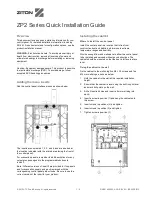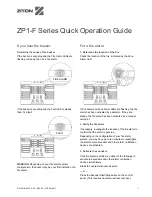
Automist
®
Fixed Wall Head Handbook v1.2.3
Plumis Ltd Copyright © 2017. All Rights Reserved.
Page 6 of 41
S MA RT SC AN
®
Automist operation
In the event of a fire, Automist is triggered automatically by a relay contact, provided by one or more
heat alarms/detectors,
1
compliant with either BS 5446-2 or BS EN 54-5
2
.
The link between detector and
relay may involve a fire panel or, more commonly, a direct wired or wireless connection between the
devices.
Once triggered, a pump drives mains water through the unique nozzle unit, quickly filling the room volume
with a dense fog. Water mist removes heat and displaces oxygen from the fire zone, resulting in fire control,
suppression or extinguishment. The intention is to lower the temperature and the accumulation of toxic
gases, thereby reducing damage and increasing survivability. Adding water to a chip pan fire can greatly
exacerbate the fire; the same is not true for water mist as the updraught from the flame and the
evaporation of the tiny droplets prevents water from reaching and collecting in the pan.
Unlike conventional sprinklers, Automist can be stopped manually by pressing a button on the pump’s
front panel, by means of an optional remote STOP button, or by cutting power to the independent
circuit on the consumer unit (marked with an indicator sticker). As Automist uses much less water than
a traditional sprinkler system, water damage in the event of activation is minimised. Where desired,
manual activation can also be provided through a manual call point.
The water mist technology also has benefits for suppressing a greater range of fire scenarios, particularly
fires that are shielded from the nozzle release point.
Watermist has a different principle of fire fighting to sprinklers which suppress fires by wetting surfaces and
directly cooling the flames with large water drops, helped by gravity. Water mist uses fine droplets that
evaporate at the base of the fire to extract heat (cool) the fire and displaces oxygen from the fire zone,
resulting in fire control, suppression or extinguishment. Thus, water mist works best when placed closer to
the ground avoiding ineffective evaporation in the hot layer in the ceiling and the upward flow of hot
combustion products. Automist leverages this phenomenon by placing the spray head half way up the wall
(around light switch height): between the hot layer and furniture. This allows increased fire suppression
performance with the same amount of water. Automist is a member of the International Water Mist
Association’s (IWMA) “Archimedes Club” for the products which utilise the optimum deployment of water
mist technology.
1
In this document the terms “heat alarm” and “heat detector” are used interchangeably
.
2
With suitable interface equipment, either BS 5446-2 heat alarms or BS EN 54-5 heat detectors may be used to
activate Automist
. Other specific alarms/detector models are also acceptable where Plumis has tested the
products and documented their use on the Plumis Partner Site library page, provided that associated Plumis and
manufacturer guidance is followed.


























